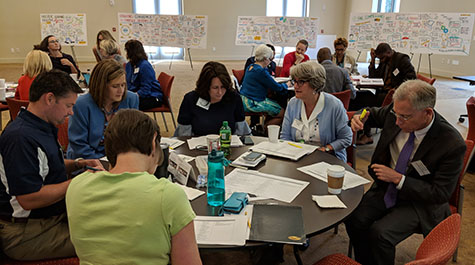School of Education leads the way in rethinking the role of K-12 school leaders
William & Mary School of Education leadership in education reform has been highlighted as an exemplary case study in Moving Toward Mastery, a national report on innovations in education from CompetencyWorks, a collaborative initiative which engages a series of organizations in advocacy for K-12 reforms, particularly deeper learning as a tool for equity.
Peggie Constantino, director of Executive Ed.D. programs; Amy Colley, executive director of the School Leadership Institute; and colleagues were featured for the work they have done to craft and implement the Virginia Profile of a Leader. This collaborative work essentially rethinks the role of educational leadership in response to a new vision of competencies required for Virginia K12 graduates.
In 2016, the Virginia General Assembly passed legislation authorizing the state’s Department of Education to re-envision future-forward education, which led to the development of the Profile of a Virginia Graduate. The profile updates Virginia’s graduation requirements for the 21st century and opens the way for competency-based and personalized learning.
Constantino and Colley contend that school leaders in the state have a unique opportunity—and critical need—to evolve with the new understanding of outcomes for Virginia students. The change comes after nearly two decades of standards and expectations imposed on educators and administrators through mandated programs such as No Child Left Behind, and would demand a considerable shift in thinking.
“This is exciting because too often we’ve said, ‘if only we had a voice in the change,’” said Constantino. “Well, now we do. It’s messy, and ambiguous, but we have a huge opportunity to bring everyone to the table to talk about where we want to go.”
The team hosted a conference in June during which leaders in education reform at the state and district levels came together to identify shared concerns, priorities, and innovations for moving forward. They will host a smaller, closed group in January to refine the recommendations, which will then be vetted by a statewide group of leaders.
“This is an initiative that will influence work all across the state. Amy and I are passionate about developing strong, skilled school leaders—school leadership being second only to teachers in their impact on student and overall school performance,” said Constantino. “In a sense, the work we are doing has been driven backwards from identifying the outcome we want. Now we have to figure out how we get there.”
Constantino pointed out that the School of Education is currently redesigning its master’s program in K-12 administration, so statewide decisions around educator and leader competencies will inform the school’s new vision for educating future administrators. “We are leading the process of leader competencies, so we have a unique opportunity to align the two.”
Constantino and Colley reported that the collaboration between William & Mary and other institutions of higher education, as well as all leaders from school districts all across the state, is an exciting innovation for state-level education reform.
“It’s a sea change to engage in dialogue and look at collaboration and understand that many higher ed institutions and many K12 school divisions can and will work together. We’re getting away from the idea of scrappy competition and getting more into scrappy cooperation,“ said Colley. “The work has gained some notice because it’s different, but it’s moving us in the direction of greater equity and deeper learning for students.”
